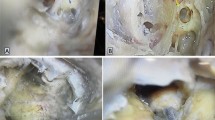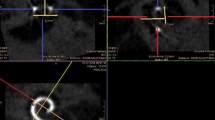Abstract
To study the postoperative visualisation of the electrode array insertion angle through transcanal Veria approach in both round window and cochleostomy techniques. Retrospective study. Tertiary care centre. 26 subjects aged 2–15 years implanted with a MED-EL STANDARD electrode array (31.5 mm) through Veria technique were selected. 16 had the electrode insertion through the round window, 10 through anteroinferior cochleostomy. DICOM files of postoperative computer tomography (CT) scans were collected and analysed using the OTOPLAN 3.0 software. Examined parameters were cochlear duct length, average angle of insertion depth. Pearson’s Correlation Test was utilized for statistical analysis. Average cochlear duct length was 38.12 mm, ranging from 34.2 to 43 mm. Average angle of insertion depth was 666 degrees through round window insertion and 670 degrees through cochleostomy insertion. Pearson’s correlation showed no significant difference in average angle of insertion depth between subjects with cochleostomy and round window insertion. Detailed study on the OTOPLAN software has established that there remains no difference between round window insertion or cochleostomy insertion when it comes to electrode array position and placement in the scala tympani. It is feasible to perform round window insertion and cochleostomy insertion through transcanal Veria approach as this technique provides good visualisation.



Similar content being viewed by others
References
Adunka OF, Dillon MT, Adunka MC, King ER, Pillsbury HC, Buchman CA (2014) Cochleostomy versus round window insertions. Otol Neurotol 35(4):613–618. https://doi.org/10.1097/mao.0000000000000269
Bhavana K, Bharti B, Vishwakarma R (2019) Round Window insertion in veria technique of cochlear implantation: an essential modification. Indian J Otolaryngol Head Neck Surg 71(S2):1586–1591. https://doi.org/10.1007/s12070-019-01677-z
Hans JM, Prasad R (2015) Cochlear implant surgery by the Veria technique: how and why? Experience from 1400 cases. Indian J Otolaryngol Head Neck Surg 67(2):107–109. https://doi.org/10.1007/s12070-015-0863-2
House WF (1976) Cochlear implants. Ann Otol Rhinol Laryngol 85(3_suppl):3. https://doi.org/10.1177/00034894760850s303
Kiratzidis T, Arnold W, Iliades T (2002) Veria operation updated. ORL 64(6):406–412. https://doi.org/10.1159/000067578
Kuthubutheen J, Joglekar S, Smith L, Friesen L, Smilsky K, Millman T, Ng A, Shipp D, Coates H, Arnoldner C, Nedzelski J, Chen J, Lin V (2017) The role of preoperative steroids for hearing preservation cochlear implantation: results of a randomized controlled trial. Audiol Neurotol 22(4–5):292–302. https://doi.org/10.1159/000485310
Koch RW, Ladak HM, Elfarnawany M et al (2017) Measuring Cochlear Duct Length—a historical analysis of methods and results. J Otolaryngol Head Neck Surg 46:19. https://doi.org/10.1186/s40463-017-0194-2
Kiratzidis T, Arnold W, Iliades T (2002) Veria Operation Updated. ORL J OTO-Rhino-Laryngol Relat Spec ORL-J OTO-Rhino-Laryngol 64:406–412. https://doi.org/10.1159/000067578
Lovato A, de Filippis C (2019) Utility of OTOPLAN reconstructed images for surgical planning of cochlear implantation in a case of post-meningitis ossification. Otol Neurotol 40(1):e60–e61. https://doi.org/10.1097/mao.0000000000002079
Lovato A, Marioni G, Gamberini L, Bonora C, Genovese E, de Filippis C (2020) OTOPLAN in cochlear implantation for far-advanced otosclerosis. Otol Neurotol 41(8):e1024–e1028. https://doi.org/10.1097/mao.0000000000002722
Roland PS, Wright CG, Isaacson B (2007) Cochlear implant electrode insertion: the round window revisited. Laryngoscope 117(8):1397–1402. https://doi.org/10.1097/mlg.0b013e318064e891
Schurzig D, Timm ME, Batsoulis C, Salcher R, Sieber D, Jolly C, Lenarz T, Zoka-Assadi M (2018) A novel method for clinical cochlear duct length estimation toward patient-specific cochlear implant selection. OTO Open 2(4):2473974X1880023. https://doi.org/10.1177/2473974x18800238
Skarżyński H, Lorens A, D’Haese P, Walkowiak A, Piotrowska A, Śliwa L, Anderson I (2002) Preservation of residual hearing in children and post-lingually deafened adults after cochlear implantation: an initial study. ORL 64(4):247–253. https://doi.org/10.1159/000064134
Skarzynski H, Lorens A, Piotrowska A, Anderson I (2007) Preservation of low frequency hearing in partial deafness cochlear implantation (PDCI) using the round window surgical approach. Acta Otolaryngol 127(1):41–48. https://doi.org/10.1080/00016480500488917
Usami S-I, Moteki H, Suzuki N, Fukuoka H, Miyagawa M, Nishio S-Y, Takumi Y, Iwasaki S, Jolly C (2011) Achievement of hearing preservation in the presence of an electrode covering the residual hearing region. Acta Otolaryngol 131(4):405–412. https://doi.org/10.3109/00016489.2010.539266
Funding
None.
Author information
Authors and Affiliations
Corresponding author
Ethics declarations
Conflict of interest
The authors declare that they have no conflict of interest.
Additional information
Publisher's Note
Springer Nature remains neutral with regard to jurisdictional claims in published maps and institutional affiliations.
Supplementary Information
Below is the link to the electronic supplementary material.
Rights and permissions
Springer Nature or its licensor holds exclusive rights to this article under a publishing agreement with the author(s) or other rightsholder(s); author self-archiving of the accepted manuscript version of this article is solely governed by the terms of such publishing agreement and applicable law.
About this article
Cite this article
Bhavana, K., Timmaraju, S., Kumar, V. et al. OTOPLAN-Based Study of Intracochlear Electrode Position Through Cochleostomy and Round Window in Transcanal Veria Technique. Indian J Otolaryngol Head Neck Surg 74, 575–581 (2022). https://doi.org/10.1007/s12070-022-03228-5
Received:
Accepted:
Published:
Issue Date:
DOI: https://doi.org/10.1007/s12070-022-03228-5




